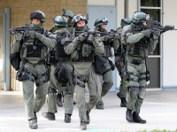The New Body Armor and Bullet Proof Vest! Get It Today!

Bullet Proof Vest are manufactured in most places across the world. The material that are used in these products can be found in many places and with many companies. Ballistic fabric is available from a number of manufacturers in various styles and compositions, each type having unique ballistic resistant properties. The body armor manufacturer may construct a given model of ballistic panel from a single fabric style or from two or more styles in combination. The location and number of layers of each style within the multiple-layer ballistic panel influence the overall ballistic performance of the panel. In addition, some manufacturers coat the ballistic fabric with various materials. For example, the manufacturer may add a layer of non-ballistic material for the sole purpose of increasing blunt trauma protection. Even composites of two or more different ballistic materials are available. As a consequence, it is impossible to compare one product with another based solely on the number of fabric layers in the ballistic panel.



The manner in which the ballistic panels are assembled into a single unit also differs from one manufacturer to another. In some cases, the multiple layers are bias stitched around the entire edge of the panel; in others, the layers are tack stitched together at several locations. Some manufacturers assemble the fabrics with a number of rows of vertical or horizontal stitching; some may even quilt the entire ballistic panel. No evidence exists that stitching impairs the ballistic resistant properties of a panel. Instead, stitching tends to improve the overall performance, especially in cases of blunt trauma, depending upon the type of fabric used.
Body armor intended for routine use is most often designed to be worn beneath the normal uniform shirt. Again, manufacturers tend to design different methods of attaching armor to the body. Hook-and-pile fasteners are common, as are "D" ring tightening straps. With the exception of metal fasteners of any type (which can deflect a bullet on impact and pose a hazard), the method of attachment is a matter of personal preference.


Another manufacturer has developed various forms of its aramid fiber for body armor. According to the founder and inventor, this fiber uses 1,000 or more finely spun single filaments that act as an energy sponge, absorbing a bullet's impact and quickly dissipating its energy through engaged and adjacent fibers. Because more filaments are used, the impact is dispersed more quickly. The creator claims their patented filament technology allows maximum energy absorption at minimum weights while enhancing comfort and flexibility. We hope that this is only the beginning of total advancements in the industry.
This type of material, when inserted and manufactured to be a new bullet proof vest significantly reduces the overall weight of the finished product, thus making vests more comfortable. The creator also contends that the normal practice of stitching the panels made from layers of this material is largely unnecessary, and that the lack of stitching contributes to a lighter weight and softer feel while affording the same protection. This is agreeable, since stitching can make the material stiff and not willing to bend.
Post Your Ad Here





Comments